
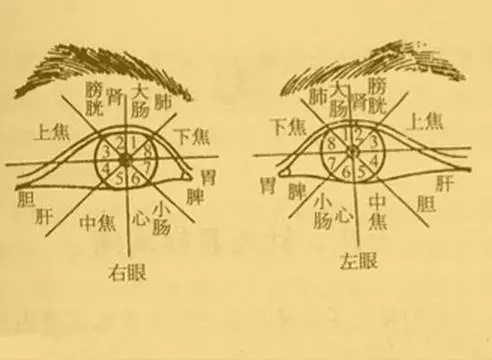 1. Symptoms Around the EyesSwollen eyelids — indicates reduced function of internal organs (kidneys, gastrointestinal, heart) leading to fluid retention in the body.Dark circles — occur when blood contains excessive waste, causing the area around the eyes to appear dull (kidneys).Wrinkles below the eyes — one of the signs of aging.Sunken eye sockets — indicates excessive consumption of body energy.White inner eyelids — a symptom of anemia.Yellowish-white small bumps on the eyelids — indicate high cholesterol levels.2. Eye ConditionsYellowing of the sclera — a warning sign of liver and gallbladder issues (jaundice).Blood vessels in the sclera — indicate liver stress causing vascular congestion.Eye twitching — a warning sign of declining immunity.3. Functional Impairments of the EyesInability to fully close eyes during sleep — indicates poor gastrointestinal function leading to muscle atrophy.Easy eye fatigue — indicates liver dysfunction.4. Eye Secretions“Eye discharge” — yellow discharge indicates “pus” (inflammation).Dry eyes — can easily lead to eye diseases.Excessive tearing — occurs when liver function is weakened.Oral Health:
1. Symptoms Around the EyesSwollen eyelids — indicates reduced function of internal organs (kidneys, gastrointestinal, heart) leading to fluid retention in the body.Dark circles — occur when blood contains excessive waste, causing the area around the eyes to appear dull (kidneys).Wrinkles below the eyes — one of the signs of aging.Sunken eye sockets — indicates excessive consumption of body energy.White inner eyelids — a symptom of anemia.Yellowish-white small bumps on the eyelids — indicate high cholesterol levels.2. Eye ConditionsYellowing of the sclera — a warning sign of liver and gallbladder issues (jaundice).Blood vessels in the sclera — indicate liver stress causing vascular congestion.Eye twitching — a warning sign of declining immunity.3. Functional Impairments of the EyesInability to fully close eyes during sleep — indicates poor gastrointestinal function leading to muscle atrophy.Easy eye fatigue — indicates liver dysfunction.4. Eye Secretions“Eye discharge” — yellow discharge indicates “pus” (inflammation).Dry eyes — can easily lead to eye diseases.Excessive tearing — occurs when liver function is weakened.Oral Health: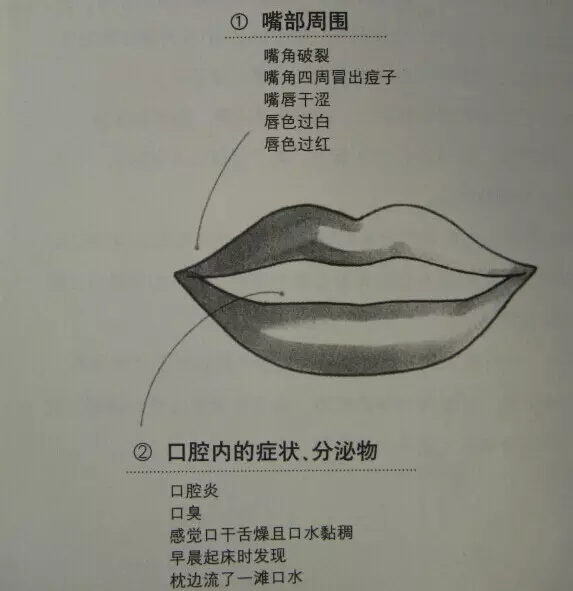 1. Symptoms Around the MouthCracked corners of the mouth — caused by gastritis leading to false appetite.Acne around the mouth — indicates weak gastrointestinal function.Dry lips — elevated body temperature can cause dry lips.Pale lips — a warning sign of insufficient blood.Red lips — indicate excessive internal heat accumulation.2. Oral Symptoms and SecretionsOral inflammation — evidence of lowered immunity.Bad breath — can have five causes (active gastritis, indigestion, rhinitis, gum disease, dental plaque).Feeling dry mouth with thick saliva — indicates systemic dehydration.Finding a pool of saliva on the pillow in the morning — indicates weak gastrointestinal function. Tongue:
1. Symptoms Around the MouthCracked corners of the mouth — caused by gastritis leading to false appetite.Acne around the mouth — indicates weak gastrointestinal function.Dry lips — elevated body temperature can cause dry lips.Pale lips — a warning sign of insufficient blood.Red lips — indicate excessive internal heat accumulation.2. Oral Symptoms and SecretionsOral inflammation — evidence of lowered immunity.Bad breath — can have five causes (active gastritis, indigestion, rhinitis, gum disease, dental plaque).Feeling dry mouth with thick saliva — indicates systemic dehydration.Finding a pool of saliva on the pillow in the morning — indicates weak gastrointestinal function. Tongue: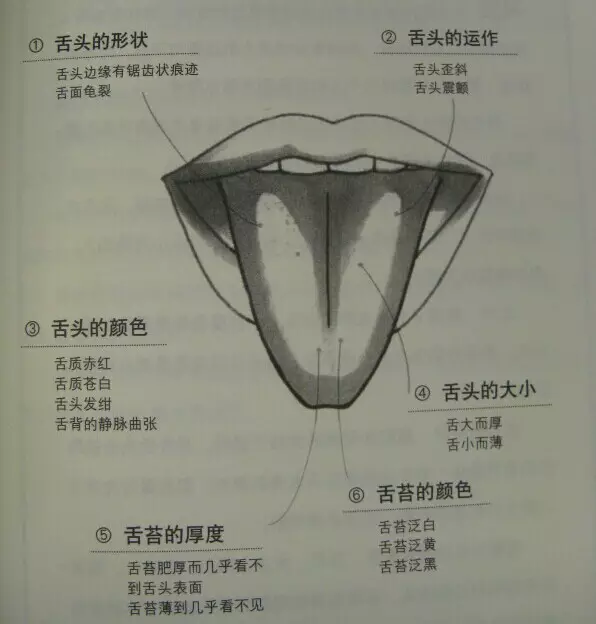 1. Shape of the TongueJagged edges on the tongue — swelling caused by excessive fluid retention.Cracked tongue surface — indicates insufficient hydration.2. Tongue MovementSlanted tongue — a signal of cerebrovascular disorders.Trembling tongue — indicates body weakness.3. Tongue ColorRed tongue body — indicates elevated body temperature.Pale tongue body — indicates body weakness.Purple tongue — a signal of thick blood.Varicose veins on the tongue — a dangerous signal of poor blood flow.4. Size of the TongueLarge and thick tongue — indicates excessive fluid retention.Small and thin tongue — indicates insufficient fluid.5. Thickness of the Tongue CoatingThick tongue coating, almost obscuring the tongue surface — indicates gastrointestinal disorders or serious diseases.Thin tongue coating, almost invisible — indicates body weakness or allergic constitution.6. Color of the Tongue CoatingWhite tongue coating — indicates low body temperature and reduced bodily functions.Yellow tongue coating — indicates internal “heat”.Black tongue coating — indicates extreme physical exhaustion. Nose:
1. Shape of the TongueJagged edges on the tongue — swelling caused by excessive fluid retention.Cracked tongue surface — indicates insufficient hydration.2. Tongue MovementSlanted tongue — a signal of cerebrovascular disorders.Trembling tongue — indicates body weakness.3. Tongue ColorRed tongue body — indicates elevated body temperature.Pale tongue body — indicates body weakness.Purple tongue — a signal of thick blood.Varicose veins on the tongue — a dangerous signal of poor blood flow.4. Size of the TongueLarge and thick tongue — indicates excessive fluid retention.Small and thin tongue — indicates insufficient fluid.5. Thickness of the Tongue CoatingThick tongue coating, almost obscuring the tongue surface — indicates gastrointestinal disorders or serious diseases.Thin tongue coating, almost invisible — indicates body weakness or allergic constitution.6. Color of the Tongue CoatingWhite tongue coating — indicates low body temperature and reduced bodily functions.Yellow tongue coating — indicates internal “heat”.Black tongue coating — indicates extreme physical exhaustion. Nose: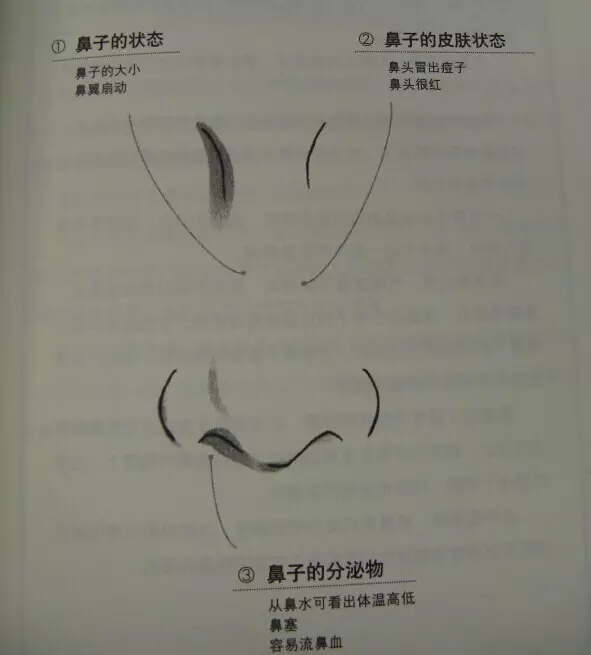 1. Condition of the NoseNose size — indicates strength of respiratory function.Nostrils flaring — indicates difficulty in breathing.2. Skin Condition of the NoseAcne on the nose — may indicate respiratory issues.Red nose tip — a signal of excessive alcohol consumption.3. Nasal SecretionsNasal discharge can indicate body temperature — treatment for colds varies based on the type of nasal discharge.Nasal congestion — if ignored, can lead to systemic hypoxia.Frequent nosebleeds — often caused by weak gastrointestinal function. Cheeks:
1. Condition of the NoseNose size — indicates strength of respiratory function.Nostrils flaring — indicates difficulty in breathing.2. Skin Condition of the NoseAcne on the nose — may indicate respiratory issues.Red nose tip — a signal of excessive alcohol consumption.3. Nasal SecretionsNasal discharge can indicate body temperature — treatment for colds varies based on the type of nasal discharge.Nasal congestion — if ignored, can lead to systemic hypoxia.Frequent nosebleeds — often caused by weak gastrointestinal function. Cheeks: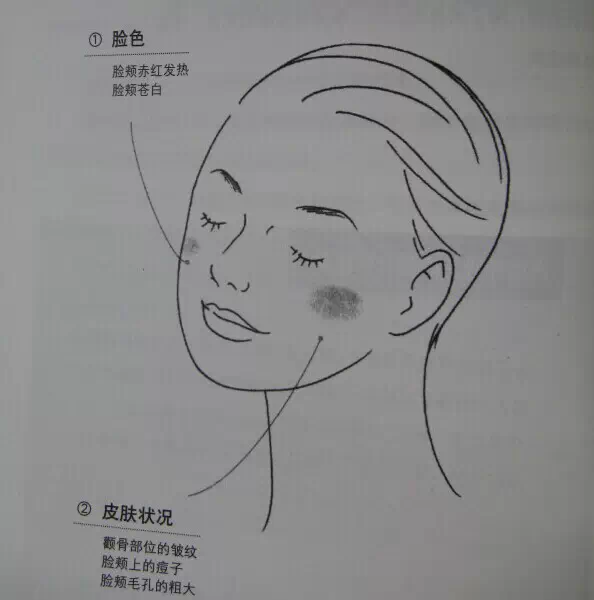 1. Facial ColorRed and hot cheeks — indicate abnormal temperature regulation.Pale cheeks — indicate insufficient oxygen supply in the body.2. Skin ConditionWrinkles on the cheekbones — primarily caused by UV exposure.Acne on the cheeks — pay attention to diet and possible constipation.Enlarged pores on the cheeks — reduced sebum is the main cause of enlarged pores. Teeth:1. Condition of the TeethProne to cavities — a precursor to osteoporosis.Gray teeth — indicate the formation of cavities inside the teeth.2. Condition of the GumsSwollen gums — indicate gastritis or fatigue.Bleeding gums — indicate gum inflammation or weak gastrointestinal function. Hair:
1. Facial ColorRed and hot cheeks — indicate abnormal temperature regulation.Pale cheeks — indicate insufficient oxygen supply in the body.2. Skin ConditionWrinkles on the cheekbones — primarily caused by UV exposure.Acne on the cheeks — pay attention to diet and possible constipation.Enlarged pores on the cheeks — reduced sebum is the main cause of enlarged pores. Teeth:1. Condition of the TeethProne to cavities — a precursor to osteoporosis.Gray teeth — indicate the formation of cavities inside the teeth.2. Condition of the GumsSwollen gums — indicate gastritis or fatigue.Bleeding gums — indicate gum inflammation or weak gastrointestinal function. Hair: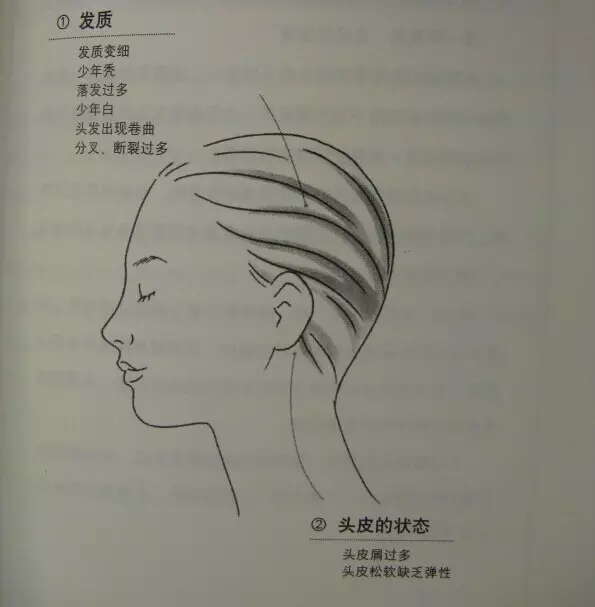 1. Hair QualityThinning hair — indicates a tendency towards anemia or aging.Adolescent baldness — excessive fat intake can deplete hair (reproductive organ decline).Excessive hair loss — can indicate early signs of disease.Premature graying — relates to calcium levels and hair.Curly hair — indicates thinning hair quality.Excessive split ends and breakage — can be caused by anemia during menstruation.2. Scalp ConditionExcessive dandruff — categorized into “dry” (iron and protein supplementation) and “oily” (improving fat metabolism, supplementing Vitamin B).Soft and lack of elasticity scalp — indicates symptoms of swelling. Nails:
1. Hair QualityThinning hair — indicates a tendency towards anemia or aging.Adolescent baldness — excessive fat intake can deplete hair (reproductive organ decline).Excessive hair loss — can indicate early signs of disease.Premature graying — relates to calcium levels and hair.Curly hair — indicates thinning hair quality.Excessive split ends and breakage — can be caused by anemia during menstruation.2. Scalp ConditionExcessive dandruff — categorized into “dry” (iron and protein supplementation) and “oily” (improving fat metabolism, supplementing Vitamin B).Soft and lack of elasticity scalp — indicates symptoms of swelling. Nails: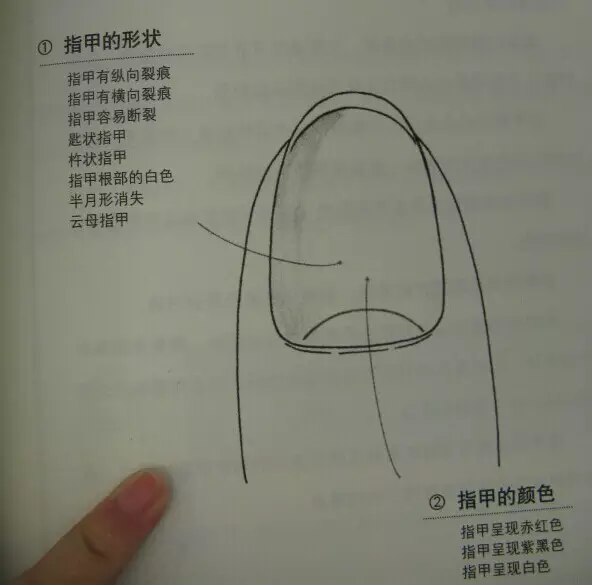 1. Shape of the NailsVertical ridges on the nails — wrinkles formed by aging.Horizontal ridges on the nails — indicate records of “past” (body discomfort).Prone to breaking nails — indicates anemia or poor liver function.Spoon nails — a distress signal from the body (severe anemia, uterine fibroids, endometriosis; detailed examination recommended).Clubbing nails (feeling of pressure and deformation) — often seen in individuals with heart disease.Disappearance of the white crescent at the base of the nails — indicates physical decline.Dry nails — indicate a dry state.2. Color of the NailsRed nails — indicate thick blood (pay attention to cardiovascular health).Purple-black nails — indicate turbid blood or poor heart function.White nails — indicate a tendency towards anemia.
1. Shape of the NailsVertical ridges on the nails — wrinkles formed by aging.Horizontal ridges on the nails — indicate records of “past” (body discomfort).Prone to breaking nails — indicates anemia or poor liver function.Spoon nails — a distress signal from the body (severe anemia, uterine fibroids, endometriosis; detailed examination recommended).Clubbing nails (feeling of pressure and deformation) — often seen in individuals with heart disease.Disappearance of the white crescent at the base of the nails — indicates physical decline.Dry nails — indicate a dry state.2. Color of the NailsRed nails — indicate thick blood (pay attention to cardiovascular health).Purple-black nails — indicate turbid blood or poor heart function.White nails — indicate a tendency towards anemia.
What Others Are Viewing (Click the title to view)
1. Surprising Truth Behind “Little Rice Grains” on the Back
2. Three Major Acupoints to Release Phlegm and Qi Stagnation Accumulated During the Spring Festival!
3. A Unique Acupoint on the Hand to Nourish Liver Blood and Brighten Eyes, Simple and Effective
4. Two Acupoints to Tap Twenty Times Daily to Prevent Stroke and Boost Yang Energy Throughout the Body!
5. Where There Is Cold, There Is Disease! Four Acupoints to Expel Cold Completely
【Learn Meridians】 Exciting Recommendations Click to Explore| Meridian Inquiry | Acupoint Inquiry | Common Disease Inquiry |
| Massage Techniques Explained | Technique Video Explanation | Pediatric Disease Inquiry |
| Hand Diagnosis | Facial Diagnosis | Nine Major Constitutions |
| Tongue Diagnosis | Back Diagnosis | Foot Reflex Zones |
If you find this useful, please click the  To Read More
To Read More

